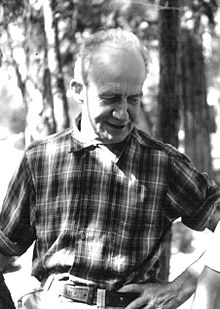John Salathé
John Salathé (born June 14, 1899 in Niederschöntal near Füllinsdorf in Switzerland ; † August 31, 1992 in California ) was a pioneer of big wall climbing in the Yosemite Valley .
Life
Hans (John) Salathé, son of a large working-class and peasant family, trained as a farrier , spent four years as a sailor at sea until he married in Montreal in 1929 . In the same year he emigrated to the USA with his wife Ida, where he opened his own blacksmith's workshop in San Mateo , California in 1933 , the Peninsula Wrought Iron Works . He went vegan and came into contact with the Sierra Club in Tuolumne Meadows .
In 1945 he began climbing in Yosemite Valley , discovering that the previous rock hooks were too soft for the hard granite of the Sierra. He developed hooks made of hard chrome-vanadium steel, u. a. so-called lost arrows , which are still manufactured and used today. The indispensable climbing aid in technical climbing, the so-called sky hooks , also go back to Salathé.
From October 13-14, 1946 he and Ax (Anton) Nelson made the first ascent of the south-west face of Half Dome - with the first bivouac in a Yosemite wall. The climb required 150 hooks.
On September 5, 1947, Salathé and Nelson reached the summit of the granite top of the Lost Arrow through the Chimney Route after five days of hard climbing with four bivouacs. They also placed bolts. The route set new standards due to the difficulty and the length of the first ascent; it was only repeated 17 years later.
From June 30 to July 4, 1950, he and Allen Steck managed the north face of Sentinel Rock , which is now a classic route. On September 5 and 6, 1951, he and Cliff Hopson managed to climb the south face of the Sugarloaf Dome . In 1953, after a mental breakdown, he left his family, returned to Switzerland and became a member of the religious community Spiritual Lodge Zurich . In 1958 he was the last mountain to climb the Matterhorn .
He returned to California in 1963 and spent 20 years hitchhiking around the country and trying to find his way around the world. a. to feed on rice, beans, barley, herbs and plants. He spent the end of his life in various old people's homes in California. In his honor, there is a great classic route on El Capitan Salathé Wall . He is considered to be one of the great pioneers, the "grandfather" of big wall climbing in Yosemite.
literature
- Allen Steck, Robin Hansen: In Memoriam John Salathé . In: American Alpine Journal. 36 (68), 1994
- Chris Jones: Climbing in North America. Berkeley, California, USA: American Alpine Club / Univ. of California Press, 1976
- Max Matter: John Salathé - an emigrant story. BGA internal. Insider information from the Alpina mountaineering group , 2011 edition
- Max Matter, Emil Zopfi: Follow the call of the angels by climbing . In: Neue Zürcher Zeitung , January 27, 2012
Web links
| personal data | |
|---|---|
| SURNAME | Salathé, John |
| ALTERNATIVE NAMES | Salathé, Hans |
| BRIEF DESCRIPTION | Swiss-American mountaineer, pioneer of big wall climbing in the Yosemite Valley |
| DATE OF BIRTH | June 14, 1899 |
| PLACE OF BIRTH | Niederöntal near Füllinsdorf |
| DATE OF DEATH | August 31, 1992 |
| Place of death | California |
